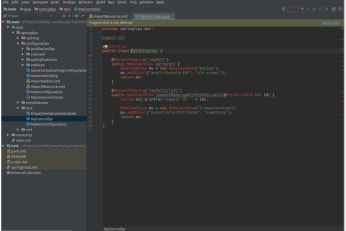

- #INTELLIJ 2016 FOR MAC HOW TO#
- #INTELLIJ 2016 FOR MAC INSTALL#
- #INTELLIJ 2016 FOR MAC WINDOWS#
Stay in touch via Facebook and Twitter for upcoming tutorials.ĭon't forget to like and share this page :) This concludes our tutorial on IntelliJ Manage Configurations - Settings or Preferences and I hope you've found it useful! There is a Scala menu item which contains additional tabs with even more options to fine tune the behavior of your Scala project in IntelliJ. Languages & Frameworks menu item in settings dialog There is an SBT menu item which allows you to fine tune a general set of SBT settings.Ħ. As an example, we are using the Simple Build Tool (SBT) plugin for our allaboutscala project. This menu item has additional settings with regards to building, running and deploying your Scala project.


Build, Execution, Deployment menu item in settings dialog As shown in the picture below, each menu allows you to fine tune their corresponding settings.ĥ. The Version Control menu item in the Settings or Preferences dialog has specific menus for each of these version control systems. If you are doing Scala programming, you would most certainly be working in teams, which could even be located in various regions across the world! Therefore, you would be contributing to a some project which would be integrated with a version control system such as Git, CVS, SVN etc. Version Control menu item in settings dialog
#INTELLIJ 2016 FOR MAC INSTALL#
To install the cucumber plugin, select Cucumber for Scala and then click on the Install button as shown above.Ĥ.This opens up another dialog and in the search box type in Cucumber.
#INTELLIJ 2016 FOR MAC WINDOWS#
As another example, say you were doing Behavior-Driven Development (BDD) and wanted to install the Cucumber plugin for IntelliJ.įrom the Settings dialog on Windows or Preferences dialog on Mac, click on the Plugins menu item and then select Browse repositories …
#INTELLIJ 2016 FOR MAC HOW TO#
In tutorial 3, we showed how to install the Scala Plugin from the settings dialog. This will open up the settings dialog as follows:
If you are using Windows, open the File menu and then select Settings. If you are using a Mac, click on the IntelliJ IDEA menu and then select the Preferences menu item. If you do not have IntelliJ installed or the allaboutscala project, please follow the previous tutorials. Open IntelliJ and our allaboutscala project The settings dialog allows you to fine tune pretty much anything in IntelliJ, such as changing your font size to installing new plugins like the Scala Plugin we added in Tutorial 3.ġ. So why should you be familiar with IntelliJ's settings? Once in the keymap menu, just search for Quick Documentation.In this tutorial, we will explore the Settings dialog in IntelliJ. Remaping can be done under IDE Settings/Keymap. Personally, Ctrl+Q on windows was not ideal so I remapped it to Alt+D. This works in the intellisense popup as well and will stay up while navigating up and down. It will pop up the documentation for anything at the spot of where your text input marker is so you never have to touch the mouse. Pretty awesome!Įdit: Going beyond the initial question, this might be useful for people who just want quick and easy access to the docs.Īfter using this for a few more days, it seems just getting used to using the hotkey is the most efficient way. Just type in ‘doc’ and you will see all the options for doc.Īlso, searching for “autopopup doc” will not only find each of the options, but it will also highlight them in the menu. The search functionality of the options menu is very useful. Not ideal… But its something.Īs another note. To see the javadoc in the autocomplete menu, hit ‘.’ to get the popup, then hover over the object you are working with, once you get the javadoc popup, you can select an item in the popup to switch the javadoc over. IDE Settings/Editor/Code Completion -> Autopopup Documentation. IDE Settings/Editor -> Other.Show quick doc on mouse move. To best mirror Eclipses functionality, enable the following settings:







 0 kommentar(er)
0 kommentar(er)
